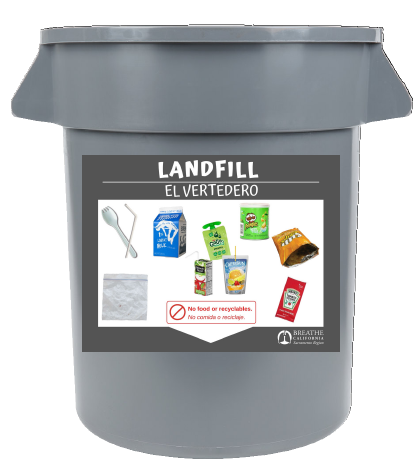California's Senate Bill 1383 (SB 1383) requires all schools to subscribe to recycling and organics recycling services. In addition, all schools must provide recycling containers alongside all trash containers and organic containers in areas where food is consumed.
The State of California (CalRecycle) regulates Local Education Agencies, including: public schools, charter schools, school districts, State colleges, and County Offices of Education. Private schools and colleges located in the unincorporated areas of Sacramento County are regulated by Sacramento County, Department of Waste Management and Recycling.
Local Education Agencies are subject to mandatory recycling and organic recycling requirements and regulated by CalRecycle. Local Education Agencies include:
- K-12 public and charter schools
- School Districts
- State Colleges
- County offices of education that are not regulated by the city or county
How to Comply: Schools must select one or more of the following options:
Self-haul recycling and organic waste to a facility that diverts the material from landfills.
Secure an Organic Recycling Waiver from CalRecycle. Have an Organic Recycling Waiver approved by CalRecycle (see the “How to Apply…” section for more information). There are no waivers from recycling services.
School faculty must also educate staff and students on proper recycling and organic recycling while monitoring to prevent contamination. If contamination is found, school employees must be notified and educated on correctly sorting recycling and organic materials.
How to Apply for an Organic Recycling Waiver:
Submit Local Education Agency waiver applications to CalRecycle. Forms and process for submitting waiver requests and notification are posted on CalRecycle’s Department-Issued Waivers webpage. A Local Education Agency may be eligible for a waiver if one of the following criteria apply:
- Inadequate space for containers
- Insignificant amount of generated organic waste
- The local education agency is located within a jurisdiction or census tract that has been granted a waiver by CalRecycle
A waiver application must be submitted for each location/address of the local education agency that requests to be waived.
Private schools and private colleges in unincorporated Sacramento County are regulated by Sacramento County, Department of Waste Management and Recycling (DWMR).
Like other commercial entities, private schools and colleges must adhere to the business recycling and organic recycling requirements. Please visit the DWMR Business webpage for information on how to comply and waiver requirements.
In addition to subscribing to mandatory recycling and organic recycling requirements, Local Education Agencies and private schools and colleges must properly label recycling and organic recycling containers. The containers must be placed along with garbage containers in all areas except restrooms. Additionally, in situations where a particular room does not generate a specific material type, a container does not need to be placed in that room. For example, if a classroom will not generate food waste, an organics container does not need to be placed in that classroom.
Waste Station Best Practices:
In areas where food scraps and recycling are generated on a school site, set up a 3-stream waste station: Grey/Black (Garbage), Blue (Recycling), and Green (Organics) for items to be properly sorted.
- In areas where no food waste is generated, set up a 2-stream waste station: Grey/Black (Garbage) and Blue (Recycling).
- Consider a table at the end of the Waste Station for students to stack foam trays. This will help to reduce workload and prevent trays from filling the garbage container.
- Use containers sized for each area based on the amount of waste that will be generated:
- In the cafeteria or high traffic areas, use 32-gallon round containers
- In low traffic areas, such as offices or classrooms, use 10-gallon containers.
- In classrooms where food scraps and food-soiled paper are generated (for example, snack time), provide a 3.5 gallon bucket with a lid. Line the bucket with a plastic bag. At lunchtime, a student volunteer can collect the material from the classroom and consolidate the material in the cafeteria.
Where Should Waste Go:
- Garbage Containers collect:
- Foam trays, foam containers, food wrappers, plastic packaging, plastic utensils, plastic straws, paper milk cartons and juice boxes, plastic bags, and sauce packets

- Recycling Containers collect:
- Firm/hard plastic food containers, plastic water bottles, cardboard, metal containers, aluminum cans
- All items must be clean (with no liquid or food residue) and dry
- Food Scraps Container collect:
- Fruits and vegetables, banana peels, apple cores, meats and bones, corn dogs (with or without wooden sticks), food-soiled papers (like dirty napkins)
Links for Local Education Agencies:
Faculty Resources for All Schools:
Educational Resources for All Schools:
- Videos:
- PowerPoints:
- For Teachers:
School Education & Outreach Newsletters:
Additional Information:
